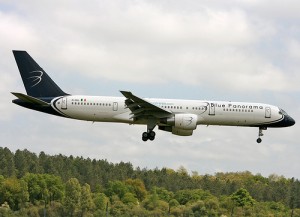
Blue Panorama Boeing 757-231
Blue Panorama Airlines sparked my interest this week for the livery blog, not only because of its unique name, but also its unique livery on the nose of their aircraft.
The airline was started in 1998 and is based in Rome, Italy. The airline has a fleet of 10 aircraft, including Boeing 737’s, 757’s, and 767’s. They also have one very cool looking Piaggio P-180 for short-haul flights.
Image: jacquesaero
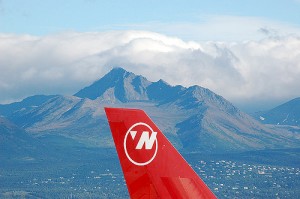
A Northwest Airline's tail up in the far north, Alaska
The website GoNorthwest.com has been operating for the past ten years, providing travel information for the Pacific Northwestern part of the United States.
Northwest Airlines, which has recently been acquired by Delta Airlines feel they own the rights to the name. This started when site owner Jack High trademarked his name last year after someone stole his site’s contents and created an illegal copy under a similar name. High defends his actions stating he has no issue with any other company using the word, “northwest,” but is just concerned about protecting his own site.
Andrea James with the Seattle PI points out that over 10,500 companies have “northwest” as part of their name, just in Washington state. There are also 366 trademarks that exist for “NW” and “Northwest” in the United States.
Delta Airlines commented that “Northwest is a world-famous mark that is used by one of the oldest airlines in the world and that has been built with billions of dollars of investments over eight decades.” The airline continued, stating they were concerned about the future of the site causing additional confusion of the brands. To me, this seems like a big company going a few steps too far. Here are some of my thoughts:
#1 The Northwest Airlines brand is going away. Delta is in the process of changing all their naming over to Delta. There won’t be any confusion in the future since the name will be gone soon. Why spend money on a dying brand?
#2 There is no record of people getting the two names confused. Even searching for ’œGo Northwest’ on Google, Northwest Airlines doesn’t show up.
#3 The look and feel of the two websites and what the companies offer GREATLY differ and it would be very hard for someone to mistake them.
#4 Should Delta go after all the companies that use the word “delta”? If one goes to GoDelta.com, it forwards you to a Delta marketing group (wow that font looks very similar). Should they be worried? How about Southwest Airlines or Alaska Airlines? When using a geographic location to name your business, you should expect there are going to be people that use part of your name in travel-related businesses.
#5 I don’t see how this is going to look good for Northwest Airlines and Delta Airlines. They should just back off now, it just isn’t worth the bad publicity.
#6 Sometimes the legal and moral lines aren’t so clear. Even if Northwest/Delta is shown to be legally right, does that make it right? Should a large, well established, world renowned airline be able to control how a very localized, small, travel website runs its business?
What are your thoughts on this? Is Northwest/Delta going too far or are they justified in protecting their brand?
Image: BobButcher
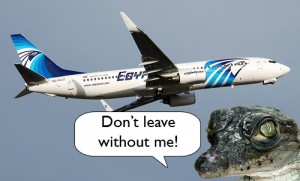
Not something you want to see while in mid-flight
About a week and a half ago I was telling you about how a scorpion got loose on a Southwest Airline’s flight. Well, Egyptair has gone one step further. Last Friday, there was a foot-long baby crocodile walking around in the aisle on a flight from Abu Dhabi to Cairo.
The crew managed to re-capture the reptile and it is currently living at the Giza Zoo in Cairo. After the flight, all the passengers were questioned and no one was willing to take credit for the croc.
Most likely someone was trying to illegally smuggle the animal and it managed to get loose while airborne. It is going to be hard to outdo a crocodile, but maybe someone out there can do it!
Photoshop by AirlineReporter
Orig photos: Brenda’s Photos, Drewski2112

View of a crashpad in New York
A lot of people in the in the business will know what a “crashpad” is, but most on the outside might have no idea. If you envision flight attendants and pilots travelling around the world staying at the best hotels, you would might be surprised to learn that most of the time they are staying at a crashpad.
So what is an airline crashpad? As it might sound, it is a place where airline employees can stay cheaply. A lot of crew do not live where they are based. For example, in this interview, Shelby lives in Texas, but it based out of New York. This means she must make the commute from DFW to LGA and have a cheap place to “crash” while waiting for her next flight. Depending on the type of crashpad, people can have their own bed and space. Others share a bed and having almost no private space.
To learn more, I interviewed Shelby (be sure to check out her blog), who works for a major US airlines. She has been working as a flight attendant since 2001. Here is our interview:
AirlineReporter: Who stays at crashpads?
Shelby:Our Crashpad is not only shared by pilots from all airlines, flight attendants from all airlines, but also with air marshals,& maintenance folks that have been displaced by their airlines. Thank goodness we are NOT all here at the same time!
AR: How big is your crashpad?
S:My crashpad has 6 Bedrooms & four bathrooms for approximately 25 people. I’m lucky, in the “Girls Room” (we call
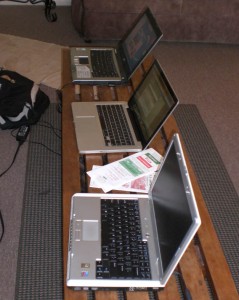
Picture of the laptops. "Seriously, we can't live without them"
it the “Presidential Suite”) there are only two of us & we have our own bathroom. I share with a First Officer. She and I both work for the same airline, which is nice, we speak the same airline language. We are rarely here at the same time, which means 90% of the time, I have the place to myself.
AR: Do you have to pay to use them?
S:Oh yes, you have to pay, the “Owners” of the crashpads actually prefer it! I pay $250.00 for my crashpad and this is considered a high amount to most folks I speak to. For this price I get, my own bed, Wi-Fi, Cable, maid service, and use of all the common areas (living room, kitchen, deck, back yard & grill)
AR: Do you like your crashpad?
S:I like my CrashPad, I am within walking distance to LGA,;it takes approximately 11 minutes from my front door to my airline operations. There are way better neighborhoods for crashpads here in New York, like Kew Gardens, which is pretty much like crew crashpad headquarters; it’s half way between LGA & JFK and a preferred area, however this means every time you fly in or out, it is a bus or taxi ride.
AR: For example, how much will you be at your crashpad this month?
S:This month I fly LGA to MIA for 3 days straight returning to the crashpad every night, so for August, I will stay in my crashpad 12 days. It is nice to know, when I return I know that my bed will be waiting for me!
AR: Are there any short-term type crashpads?
S: Yes, they are called ’œhot beds’, meaning, they are 1st come 1st serve. They can run anywhere from $20.00 per night to $175.00 per month! When they arrive they have to find a bed, make up their bed, and crawl in, all the while trying not to wake up the others sleeping around them. This is one reason I pay more. After a long day, I like knowing that I have my bed, with my sheets, in my room to crawl into.

The nicely kept shared kitchen needs to stay clean!
AR: Which was your favorite crashpad?
S: When I was based in Chicago, we stayed at the DoubleTree Suites. We had seven flight attendants that shared one suite! The hotel had a nice Gym, Pool, Happy Hour, Free Breakfast ’¦oh and the Double Tree COOKIES!!! (which is why we needed the gym).
AR: Which was your least favorite?
S: Was when I was a new hire, all the classmates that I graduated with piled into a cheap nasty hotel… 10 of us 2 beds. ’œ Are you Serious??’ I stayed 4 hours & left!
AR: With all those people sharing a shower, how do you work it out?
S:Since I’m lucky now & only share with one, it is not an issue. Most crash pads have signup sheets for “Shower Time”, based on what time you fly the next day. Trust me, you know your fellow crashpad
buddies. You do a lot of things in the dark & a lot of tip-toeing is going on in the wee hours of the morning.
Some other questions that some fine followers of Shelby on Twitter asked:
Who does the dishes?
If you want to make your fellow crashpaders angry, don’t clean up after yourself. You will be asked to leave ASAP! You do your own dishes!!
Who washes your sheets?
Well, If you stay at a hotel crashpad, they are usually done for you. If you live in a single family home, hopefully the owner of the crashpad has a washer & dryer and they let you use it. We don’t have
one here at our crashpad. Thank goodness we have lots of Laundromats, in our neighborhood.
Who puts the CrashPads together?
My CrashPad is run by a New York Cop! A lot of pilots & flight attendants run their own crashpads, I believe, out of years of frustration! There is this one crashpad here in New York that is affectionately called the “Sticky-Note” crashpad, because the owner is constantly putting up Sticky Notes on what NOT to do, I mean they are everywhere!
Thank you Shelby for the interview and if any of you have any additional questions, let me know and I will ask her!
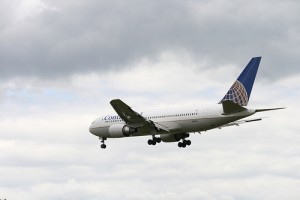
Continental Boeing 767-200 much like the one involved in this incident.
Continental airlines flight 128 from Brazil to Texas hit a bad patch of turbulence, injuring over 30 passengers. The Boeing 767 was about six hours into its flight when all of a sudden the aircraft lost altitude. Passenger Fabio Ottolini stated, “People didn’t have time to do anything.” He stated that flight attendants were in the middle of service when the incident occurred, causing some to hit the ceiling. The aircraft landed in Miami where 13 people were taken to local hospitals and four were seriously injured.
This is reminder that everyone should keep their seatbelts on while in flight. Yes, it is very tempting to take the belt off, but it is never worth the risk. The Science Christian Monitor reports that from 1980 to June 2004, airlines in the United States had 198 turbulence accidents, resulting in 266 serious injuries and three fatalities. The three fatalities resulted in passengers not wearing their seatbelt, while the fasten seatbelt sign was illuminated.
For updates on this story, check out Ben Mutzabaugh’s blog, Today in the Sky.
Image: sohvimus






